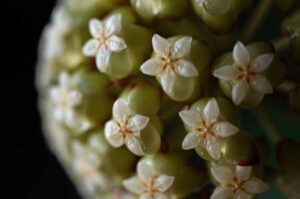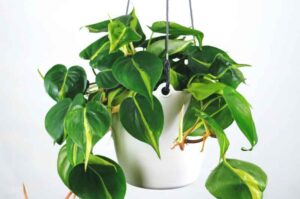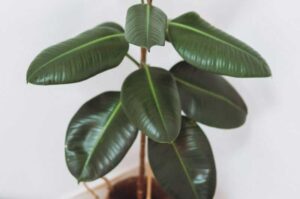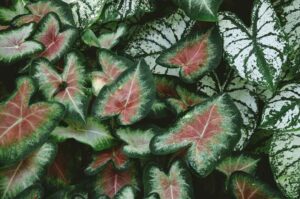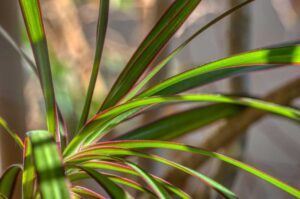Why Is My Caladium Dying? (Causes and their solutions)
Caladiums are well-known houseplants grown for their attractive multicolored foliage. Although they are famous as easy to care house plants, there are many growth factors, which are if not taken care of, then you will end up dying your Caladium plant. This article will help you to find out all the causes, for which your Caladium plant is dying.
The major causes for which your Caladium is dying are Overwatering, Underwatering, Temperature stress, and Overexposure to sunlight. Along with these major causes, other deciding factors for the survival of your Caladium plants are humidity, fertilizers, and proper potting soil.
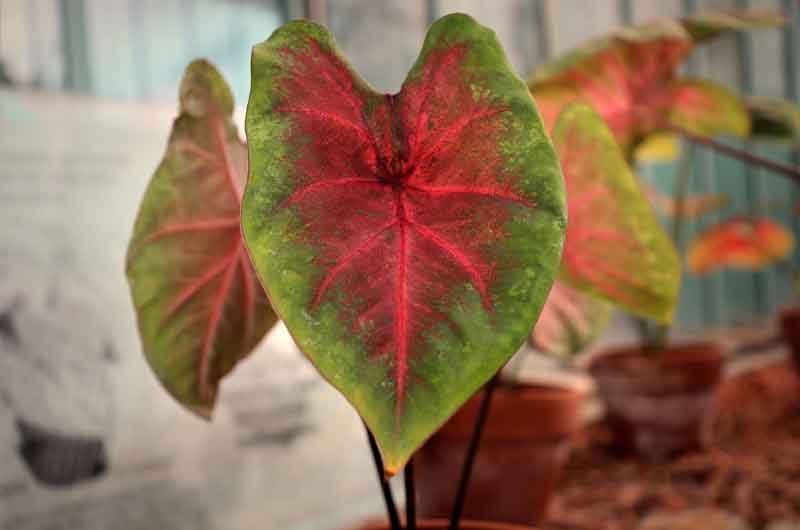
A careful inspection of your plants will let you know what is the exact reason your plants are suffering for. This is because Caladiums give distress signals and signs when something or the other is wrong with them.
So knowing these signs and attending to your plants accordingly will prevent your plants from dying and revive your already dying lot.
Causes for which your Caladium is dying
Here are a few common reasons which are mainly causing the death of your Caladium plant.
Analyzing each of them will make you more clear about the issue and help you to revive your plant easily.
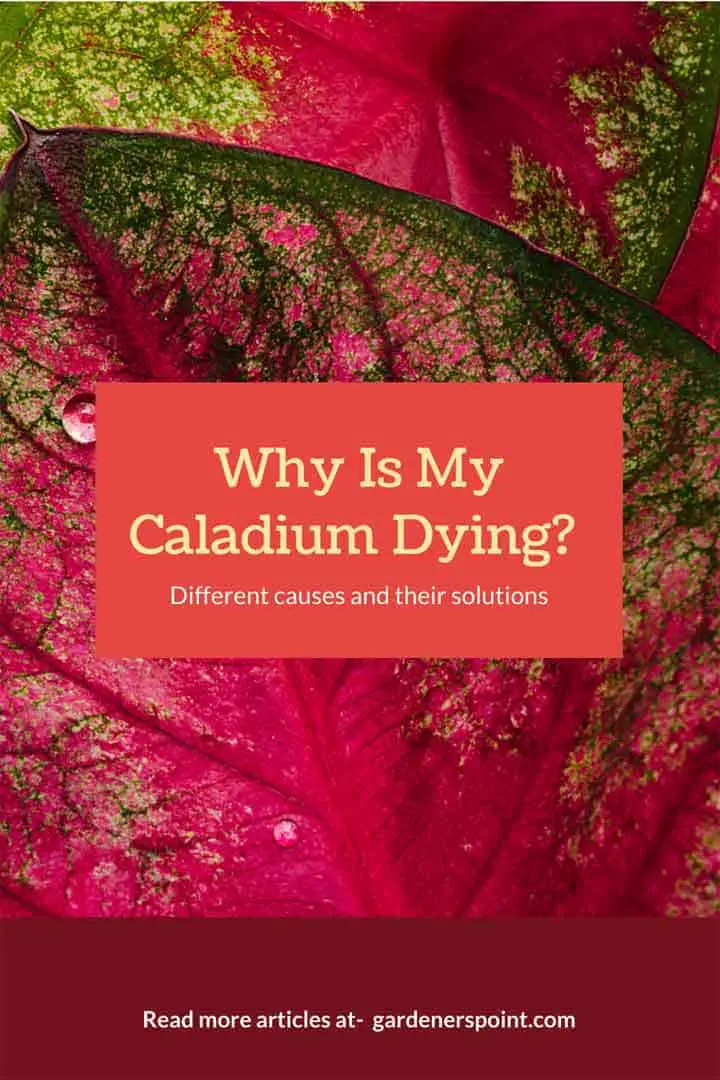
Overwatering
When you keep watering your plants more than it needs and more than what the soil can hold, this condition is called overwatering.
Overwatering is easily spottable as when it occurs the soil becomes soggy and muddy due to the overwhelming amount of water that the plant cannot take up nor the soil can absorb.
Overwatering can adversely affect your plants and cause root rot and root infections. This happens because when there is excess water in the soil it blocks up the air cavities and pushes any remaining air out. A prolonged period of waterlogging situation will eventually cause root rot, and in severe cases, the plant will start dying.
Your plant will show the following symptoms of overwatering
- Leaves become yellow and start wilting.
- The plant will look droopy.
- A long period of overwatering causes root rot and also leads to the death of your plant.
How to prevent a Caladium from overwatering
- Use well-drained potting soil. It will decrease the chances of waterlogging.
- Use a large enough pot having enough drainage holes so that the extra water can easily flow out.
- You can modify your watering habit. Instead of applying water in a fixed interval of time, apply water on the basis of your plant’s demand.
- For this, you can check whether the potting soil dry or wet, by poking your finger one to two inches below the soil. Go for watering only when the soil id dry.
- Keep your plant in a well-aerated place, getting a good amount of bright indirect sunlight. It will increase the rate of evapotranspiration.
Checking overwatering issues is not at all a hard job so you can do this easily and you can save your plant from dying.
You may also like this article – How to make potting soil for indoor plants
Underwatering
Underwatering is the exact opposite condition of overwatering. When you do not water the plants when it needs to be watered and leave the soil dry, which in turn dehydrates the plant, this condition is called underwatering.
Underwatering dehydrates the plant and the effects appear as wilted leaves and brown edges, this also results in curled-up leaves as the plants try to stop water loss by transpiration. And just like overwatering, this can also kill your plants if not treated properly.
Under watering can be caused due to
- Negligence when it comes to watering the plant.
- Keeping your plant in direct sunlight. This evaporates the moisture from the soil and also the plant’s leaves, which subsequently causes dehydration.
- Using potting soil that cannot hold water.
How should I prevent my Caladium from Underwatering
Addressing the above mentioned causes of under watering will solve the issue.
- Check the potting soil regularly, by poking the finger. If it is feeling dry, immediately go for watering.
- Use potting soil with good water-holding capacity. Adding some coco peat also increases the water-holding capacity of your soil. You can make coco peat at home. Read our detailed article on How to make cocopeat at home.
- Don’t keep your plant under direct sunlight. It will prevent extra water loss due to evaporation.
- Keep your plant in a pot according to its size. Small-sized pots will have less potting soil inside them, which holds less water. So you have to water more frequently.
You may also like- How to water indoor plants while on vacation?
How often should I water my Caladium?
There is no strict rule for watering a Caladium plant. The water requirement of these guys varies according to their size, location, season, and atmosphere.
You have to regularly check when your plants are demanding water.
As a rule of thumb when it comes to watering, check the soil by pushing one finger down 1-2 inches into the soil. If you can do that easily that means the soil is moist and it does not require watering. If that is not the case water your plant.
Overexposure to Sunlight
Caladium plants like bright indirect sunlight. That is to say that these plants require light but the direct rays from the sun tend to harm them and so should be kept in such a place that protects them from the same.
If the plants are kept exposed to direct sunlight for long durations of time, there are high chances of getting sunburned. This can also happen if the plant is suddenly brought out in light after being kept in a relatively shady area.
If your plant has suffered sunburns you will notice brown patches on the surface of the leaves. Along with sunburns, the plants might also turn yellow as in the case of overwatering.
Prolonged exposure to the sun might even kill the plant.
What is the ideal lighting condition for a Caladium?
Caladiums are tropical plants native to Central and South America. In their natural habitat, they grow beneath huge tropical plants.
So they are adopted to a diffused sunlight. Their leaves seldom experience direct sunlight.
To mimic their natural habitat indoors, A place getting enough bright indirect sunlight is best for a Caladium plant.
Although they can tolerate low light conditions a few often, extreme low light will gradually stop the plant growth.
You can get a perfect position for your plant by following the points given below.
- Create a layer between the plant and the window-pane with a white curtain or similar piece of white cloth. This will allow the plant to bathe in bright light while keeping the direct rays of the sun away from scorching the leaves of the plant.
- Light intensity falls drastically as we move away even by inches from our windows. Exploit this fact and place the plant a few inches away from the windows to prevent direct rays and hight intensity sunlight which brings the heat with it from falling on the leaves.
- Northern windows are the perfect placement for the plants as they do not receive direct sunlight throughout the day.
Temperature Stress
As mentioned before, Caladiums are tropical plants and being so, demand high temperatures for their healthy survival.
The normal temperature for the healthy growth of a Caladium plant is in the range of 70-75 F in the day and 60-65 F at night. Whereas the ideal temperature for the storage of the plant tubers is around 60-90 F.
They are highly intolerant to temperature fluctuations and suffer when the surrounding temperatures are cold. They will particularly die if the surrounding temperature falls below 25 F.
So if you are keeping your plants in a cold place that receives continuous cool air drafts then you should immediately remove them to a warmer area.
You may also like this article – Do plants grow at night – Impact of darkness on plant growth
Low Humidity Levels
Humidity also goes hand in hand with temperature for these plants. That means they require high humidity levels in the surrounding air to survive just like they need high temperature.
Humidity is the measure of water content or moisture content in the air. When it falls down the leaves droop and turn yellowish. Low humidity levels are in no way good for Caladium plants.
Preventive measures
Well people who are not properly informed turn to misting as a solution. While misting might temporarily provide moisture to the leaves, it is in no way a permanent solution. This is because misting does not increase the moisture content in the surrounding air.
Here are three things you can do to increase the moisture content of the surrounding air.
- Use a humidifier: This is the most popular method of increasing the moisture levels around plants. All you need is a humidifier and electricity and you are done.
- Group your plants: This is a natural method for increasing the moisture content of the air. Plants release water by transpiration and this helps increase the moisture in the surrounding air.
- Another DIY method to keep the humidity levels up around your plant is to make a humidity tray.
- A humidity tray mainly consists of pebbles or peat moss that is submerged in water. The plant is kept on top of the setup. The water evaporates throughout the day and keeps the moisture levels up around the plant. When using this method make sure that the roots of the plants are in no way touching the water and also change the water from time to time to prevent bacterial growth.
Learn to make one by CLICKING HERE.
Fertilization issues
Fertilization is important for any plant’s growth. But doing it wrong can cause harm to the plant to a point of no recovery. So you should be careful while fertilizing your Caladium plants as they are sensitive to overfertilization and under fertilization.
If your plant is suffering from overfeeding (another name for overfertilization), you will notice white powder-like salts appearing on the soil. This is nothing but the leftover fertilizers that were not required by the plants.
This happens when you use too much fertilizer which the plant does not require.
The excess salts accumulate on the surface of the soil and prevent the plant from taking up water thus dehydrating it. Also, too much fertilizer affects the soil and turns it infertile. And if kept in ignorance for long might kill your plant.
Overfeeding issues can be resolved by long deep waterings to drain out the excess salt. If the soil is beyond recovery then taking the plant out and putting it in a new pot is recommended.
Fertilizers should be used carefully when it comes to Caladium. Ideally, it is recommended to use them during the growing season and that too in a dilute liquid state or form of slow-releasing pellets.
Improper potting soil
Potting soil is crucial when it comes to the growth and survival of a houseplant. And the same goes for Caladium.
Using potting soil that cannot hold water at all leads to underwatering problems while potting soil that is not well-drained causes overwatering problems.
If the soil does not contain essential nutrients like nitrogen and phosphorus the plant will have a hard time growing and severe deficiency can even kill them.
Thus, for healthy growth and also to revive your dying Caladium plant, the selection of proper potting soil is a must.
Choose one that is well-drained (a mix of damp soil and peat does the trick) and has the mentioned nutrients. The suggested pH level should be around 5.5-6 (on the acidic side).
Pests and Disease
As a rule of thumb, one should always keep an eye on their plants for any signs of pest attack or diseases. Because most of these are easily visible to the naked eye. Pests like aphids, mealybugs, spider mites, etc are regular attackers of houseplants.
You can protect your plants against pest attacks by wiping the leaves of your plants once in a while with water to keep them clean. And if you spot any pests as such you should use organic insecticides to get rid of them.
But remember, try to avoid chemical pesticides because these are harmful to the plants and the environment in the long run.
Final Words
Caladium plants are easy to maintain even if it seems quite intimidating. All you need to do is look for distress signals, spot the reason, and tend to it immediately. And if you can do it right your dying plant will be revived in no time.

